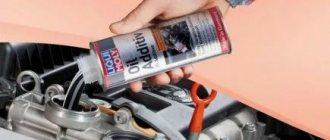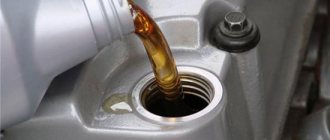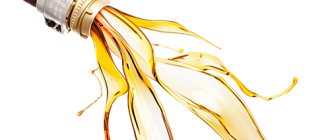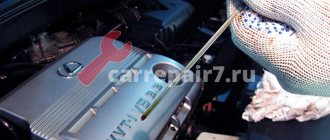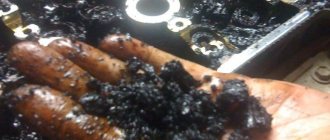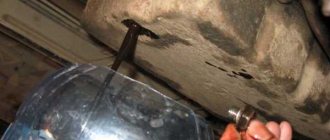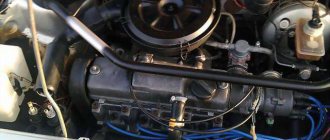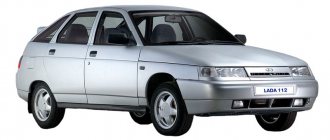Flushing the engine before changing the engine oil is a procedure that drivers carry out for various reasons. The engine is flushed to remove heavy contaminants from the lubrication system, during the transition from one type of oil to another, as a result of malfunctions that intensively contaminate the oil system, etc. Note that there are several ways to clean the internal combustion engine. You can use special flushes into the used oil (the so-called “five-minute flushes”), add flushing oil for a short period of time, or even drive some flushes for several tens of kilometers in moderate mode.
We also recommend reading the article about whether it is worth using a flush before changing the oil. From this article you will learn about cases when this procedure is necessary or may be useful, as well as when it is better to refrain from flushing the engine.
In parallel with this, for many drivers, flushing the engine oil system with diesel fuel remains the preferred option. The main argument is that for such washing there is no need to separately purchase ready-made washing compositions, which saves money. In this article we will look at this cleaning method in more detail, and also talk about the advantages and disadvantages of such a solution.
Positive effect and possible negative consequences
Diesel fuel has excellent dispersing ability. That is, it dissolves even old deposits of various natures, including sludge. Therefore, many motorists 20-30 years ago actively used diesel fuel as a liquid for flushing engines. That is, in those days when engine parts were massive with an impressive margin of safety and minimal requirements for fuels and lubricants.
In addition, some diesel fuel, which will certainly remain in the engine crankcase, will not have a pronounced negative effect on the new oil. After flushing the engine with diesel fuel, it is not necessary to somehow expel the remaining diesel fuel from the crankcase or to fill and drain fresh oil several times.
This method of cleaning the motor is also relatively inexpensive. Compared with cleaning agents, and even more so with specialized oils, washing the engine with diesel fuel will be several times cheaper.
This is where the positive aspects of this procedure end. Let's briefly look at the possible negative consequences.
- Lumpy detachment of solid deposits. Sludge build-up accumulates on static surfaces in many motors. Diesel oil can simply separate them from the surface and dump them into a pan. Or run it into the oil channel. Which will cause partial or complete blockage and oil starvation of any friction pair.
- Negative impact on rubber (caoutchouc) and plastic parts. The vast majority of modern seals and retainers in engines made of plastic and rubber are resistant to the chemical effects of any petroleum products. But diesel fuel can completely destroy “tired” non-metallic parts.
- Possible damage to the liners and the formation of scuffing in the ring-cylinder friction pairs. Diesel fuel does not have sufficient viscosity to create any strong protective layer.
All these consequences have the status of probable. And they will not necessarily occur in every individual case.
Power unit flushing products: what to choose
All commercially available compositions intended for cleaning engine parts from carbon dioxide deposits and various slags are divided into 3 groups:
- special flushing oils;
- additives for gentle flushing;
- additives for quick flushing (five-minute liquids).
Flushing oils differ from conventional ones in their less viscous consistency, which allows them to penetrate into all stagnant zones of oil ducts, and in an expanded package of detergent additives. They are made on a mineral and synthetic basis and are sold in canisters with a capacity of 4 and 5 liters. When flushing, this composition completely replaces the previously drained old lubricant and acts for 10-15 minutes with the engine running, after which it is also drained.
Oil change kit with flushing
Using good quality flushing oils is the best cleaning method that gives a positive result and does not harm the parts of the power unit. Well-known brands Liqui Moly and Castrol specialize in the production of such compositions. The disadvantage of this method is the duration of the procedure; you will have to spend at least 1 hour on it, which is important for too busy motorists.
Special chemicals and additives for washing
The most well-known and proven manufacturers of gentle additives are the Hi Gear and Bbf brands, although you can see many liquids of other brands on sale. They are produced in plastic and tin containers with a volume of 400-500 ml and are a mixture of detergent components added to the crankcase during operation. For example, the instructions for the American Hi Gear flush read as follows:
- to clean an engine with low wear, you need to add an additive 200 km before changing the oil at the rate of 1 can per 4-5 liters of engine lubricant;
- In a worn-out engine or with a mileage of over 70 thousand km, you need to fill 2 cans: one 1500-2000 km after changing the oil, the second 200 km before the next one.
Detergent additives Liqui Moly and Runway
Additives in this group are easy to use and quite effective; they are well suited for busy people who do not have time to bother with flushing oils. According to user reviews, engine cleaning fluids do not cause any complaints, except in cases of improper use.
“Five-minute” washes (for example, from the Runway brand) are an aggressive liquid designed for a volume of up to 5 liters of oil and designed to quickly clean the engine. They are used like this:
- After making sure that the level of used lubricant is halfway between the minimum and maximum marks, pour “five minutes” into the engine.
- Start the engine and let it idle without revving for 5 minutes.
- Drain the waste along with the additive, change the filter and fill the crankcase with new lubricant.
This type of flushing is considered the most harmful to the rubbing parts of the power unit and rubber seals, despite the manufacturers’ assurances of the safety of the product. Not only is the liquid quite aggressive, but in such a short time it does not have time to thoroughly flush all the channels. The only plus is ease of use.
About traditional cleaning agents: diesel fuel, gasoline and kerosene, acetone and others
In Soviet times, when the choice of chemicals for car maintenance was very limited, drivers washed power units with various available liquids, including:
- What is the best way to flush the engine before changing the oil?
- diesel fuel;
- kerosene, solvent;
- acetone;
- various oils - “spindle”, transformer, diesel.
The listed drugs served as ingredients for the creation of folk detergents, because it is unacceptable to pour diesel fuel or acetone into the engine in its pure form. Transformer oil was mixed with diesel fuel in a 1:1 ratio or with kerosene (400 ml per 2.5 liters of lubricant). Afterwards, this mixture was poured into the crankcase and allowed to idle for 15-25 minutes. At that time, the recipe worked well.
Modern cars are very different from the old Zhiguli and Volga, where the compression ratio was low, there were no sensors and electronics, and cheap alloys and metals were used for the manufacture of CPGs and valves. For this reason, the use of such mixtures, especially those containing acetone, is unacceptable in all new engines. You can wash engine parts with kerosene or diesel fuel only individually, when the unit is completely disassembled for repair.
In what cases should you absolutely not wash your engine with diesel fuel?
There are two cases in which flushing the engine with diesel fuel before changing the oil is more likely to have a negative rather than a positive effect.
- A very tired engine with a lot of output. It is not without reason that some car operating instructions say that after a certain operating time (when the engine wears out and all the gaps in it increase), it is advisable to start filling in thicker oil. This is done to compensate for gaps due to the thicker and more durable oil film created by thick oil. Diesel fuel has a very low viscosity. And even with its short-term use, metal-to-metal contact in all loaded friction pairs will be irreversible. The result is accelerated wear to the limit and a high probability of jamming.
- Modern technological engines. There is no question of using regular oil with the wrong viscosity. And using diesel fuel as a flush at a minimum (even with a single fill) will significantly reduce the service life of the motor.
It is theoretically possible to use diesel fuel as a flushing fluid on engines that are primitive by modern standards (old non-turbocharged diesel engines, VAZ classics, outdated foreign cars).
Modern service – is it worth experimenting?
Cleaning the engine using solarium was still somehow appropriate in those distant Soviet times, when the quality of the oil left much to be desired, and the engines that were washed were developed back in the days of dear Leonid Ilyich, i.e. in the 70s of the 20th century. Today, when there are a huge number of modern cars on the roads, equipped with even more high-tech computerized systems, washing with diesel fuel is more like heresy than the truth.
If you, for example, tell a German or, God forgive me, an American about this, he will probably have a heart attack. After all, when you pay more than 50 thousand euros for a car and at the same time at a certain hour you begin to wash something in your garage with something... The first thing that happens is the loss of the warranty on the car and surprised looks in the back of the home-grown auto mechanic.
Reviews from motorists who have tried the diesel fuel flushing method
Good reviews about the method of washing an engine with diesel fuel are mainly left by owners of outdated equipment. For example, drivers often wash ZMZ and VAZ engines with diesel fuel. Here, in most cases, there are no pronounced negative consequences. Although it is not a fact that in one wash the car owner did not reduce the engine life of thousands by 50 km.
You can also find negative reviews on the Internet. For example, after filling with diesel fuel, the engine seized. After disassembly, worn out and twisted liners were discovered.
Therefore, the conclusion about this method of cleaning the engine is this: you can use diesel fuel, but carefully and only on well-preserved outdated engines.
Flushing the engine with diesel fuel before changing the oil is an old, but reliable and simple way to clean the power unit. Today, many drivers laugh at the “eccentrics” who use this washing method. Diesel oil makes it possible to remove dirt and carbon deposits without the use of aggressive additives.
You don’t have to worry about engine parts that can be damaged by aggressive influences. By flushing the engine with diesel fuel, it is possible to simply, inexpensively and safely extend the service life of the engine.
Content
Is it necessary to wash the engine?
If good oil is poured into the engine, then there is no chance of deposits forming.
Diesel fuel or kerosene are indispensable cleaning agents for parts, assemblies, and a block, if they are disassembled and available for washing.
However, flushing the internal cavity of the engine clean is questionable. The cylinder block has channels, hard-to-reach labyrinths, from which it is difficult to remove diesel fuel used as a flushing liquid. So, you need to stock up on five liters of diesel fuel or kerosene and a filter (not expensive).
Mixed oil and diesel fuel in a ratio of 60/40
It is necessary to provide a high-quality filter and engine oil from the manufacturer, which will be filled in after washing the engine.
When is rinsing necessary?
When a vehicle is used, resin accumulates in the lubricating system of its internal combustion engine. Carbon deposits appear on the walls of oil channels, which can significantly impair oil circulation and reduce cooling efficiency. The situation is aggravated by pouring low-quality oil fluid. All highways may become clogged. Every ten to fifteen thousand kilometers the car oil is changed. However, if the car was operated in harsh conditions with poor lubrication, then filling with fresh petroleum product will be pointless without cleaning the gasoline/diesel internal combustion engine.
The oil has not been changed for a long time
It is necessary to flush the engine with diesel fuel before replacing the lubricant in the following situations:
- switching to a different type of motor oil;
- pouring lubricant into a newly purchased car (provided that you do not know the brand of oil that was previously filled);
- penetration of coolant or fuel into the oil liquid;
- completion of a complete overhaul of the power unit.
Let's weigh the pros and cons
Of course, since you are reading the article, you are a caring owner. And at a minimum, try to extend the life of your engine - this will save money in the future on buying a new car or replacing an old one. But is the washing process really necessary? Will it do any harm?
Cases when major cleaning is necessary:
- The motor has considerable mileage. During long-term uninterrupted operation, clots consisting of tarry deposits, scale on the walls, and slag accumulate inside the power unit. The longer a car is used, the more consumables it has. If you want to extend its life, then rinse it.
- If you don’t know what’s in the box and don’t want to risk mixing possibly incompatible liquids
- In cases of change of manufacturers or types of fuels and lubricants. Without flushing, at best, you will get a lubricant with average properties that will behave unpredictably under extreme conditions. At worst, a breakdown of the lubrication system or the internal combustion engine as a whole.
- If there is a suspicion that cooling components have gotten into the oil when using the car. As a result of breakdowns of individual components.
- After a major overhaul of the “heart”. Due to such work, small particles of used lubricants or scattered scale may remain inside. Without flushing, they will worsen the passage of lubricant through the channels intended for this purpose.
- Using the machine for a long time under extreme conditions: low or high temperatures outside, high speeds, dusty or polluted operating environment
- Inside is a turbocharged engine, which is especially sensitive to dirty lubricant and can be seriously damaged. For such models, a “major bath” is required much more often - every 3-5 thousand km.
Features of the washing procedure
The main reason for washing the engine with diesel fuel is to completely cleanse the internal combustion engine of past lubricant and contaminants. Often, liquids are used for cleaning that can dissolve solids, resin and old oil residues. Usually, special additives are added to the car oil before draining. You can also fill in the flushing agent after draining the used consumables. Today's flushes perform their task well, but they are expensive and considered quite aggressive. If they are added to the engine, they can destroy its parts.
Frequent oil changes, better than flushing
Diesel has long been used by those who needed to flush the engine. In the past, it was the most effective flush of all. Diesel oil perfectly dissolves resin and old grease residues. It is fluid, and when passing through the oil channels, it dissolves slag, carbon deposits, and clots of motor oil, and removes them from the power unit. In terms of its own cleaning characteristics, diesel can adequately compete with special products that wash the engine. At the same time, it does not harm metal elements, linings and seals. The reliability of flushing the internal combustion engine with diesel has been tested over decades of operation of cars of different models.
Experienced drivers who clean the engine with diesel fuel advise mixing it with motor oil. A similar mixture is obtained by mixing the same amount of diesel and lubricant.
Why is a heavy shower harmful to the engine?
On the other hand, there are a number of contraindications. Mainly depending on the cleaning procedure itself.
Engine washing is carried out in 3 stages:
- Removing used grease
- Filling the cleaner
- Draining the cleaning liquid
As a result of using a “diluted” lubricant, we have:
- Fast resource depletion
- Poor performance of the lubricating function
- The emergence of an emulsion
- Foaming lubricant and other “delights”
- Reducing viscosity is the main characteristic that a car enthusiast relies on when filling a new petroleum product.
How is flushing performed?
The engine is washed with diesel after draining the old motor oil. Draining is performed as standard, through a hole in the crankcase pan.
- Place your car on an inspection ditch or a special overpass.
- Using a special tool, loosen the drain cap.
- Place a pre-prepared container under the drain.
- Remove the cover by sharply pulling it to the side. This is necessary so that the stream of oil is directed exactly into the container.
- Wait until all the consumables have been drained.
- Remove the car oil filter. This is usually done manually, but if necessary, you can use a key.
- Install a temporary oil filter. It is only necessary for the engine flushing procedure, so it is advisable to purchase the most inexpensive product.
- Quickly pour diesel into the internal combustion engine (you can mix it with lubricant or use kerosene). Three liters will be enough. The initial impulse of the filling jet is needed so that the diesel fuel spreads throughout the entire power unit. The diesel will pass through the lubricating complex and flow out of the drain. This will eliminate the most serious contaminants and waste oil residues.
- Close the oil pan drain cover.
- Pour diesel into the internal combustion engine. Pour as much diesel fuel as you usually pour lubricant.
- Run the engine for a short time to run it in boost mode.
- Make sure that the internal combustion engine does not reach operating temperature.
- Turn off the motor.
- Remove the drain cover.
- Drain the diesel engine. If you notice that dirt particles come out along with the last drops of diesel fuel, repeat the rinsing.
- When clean diesel fuel starts flowing from the drain, close the lid.
- Remove the temporary oil filter.
- Install a new oil filter for further operation of the vehicle.
- Fill with fresh oil.
- Check the power unit for leaks.
If you did everything correctly, then the washing can be considered complete.
Possible consequences - the result is not always expected
Indeed, you can clean the engine very quickly with flushing liquid. But with some motors, after a short time, strange things begin to happen. The level is normal, but there is no pressure. If you continue to use it, the engine may completely fail, which has happened to some. Disassembly reveals heavy deposits, contamination, the oil intake screen is clogged with a viscous resinous substance.
Sometimes it is possible to resuscitate an engine without replacing parts - it is simply washed and reassembled. It happens that the consequences are very serious; first of all, the cylinder head suffers: the camshaft is worn out. There was practically no lubricant reaching the head parts; they were starved of oil. It has already been noted that the oil intake screen was clogged. Why did this happen, since the engine was washed and clean oil was filled in?
To create flushing fluids, the cheapest mineral oils with low lubricity are used
It should be noted that this happens, as a rule, with engines into which low-quality oil was constantly poured; the replacement interval was not observed. They have a good mileage, but the operating conditions are difficult. All of them individually and together led to failure after washing. Sediments, collecting primarily in the pan, accumulate over the years. They adhere tightly to the metal and do not pose a threat in themselves.
When the flushing liquid enters the pan, it actively dissolves deposits, but the allotted time is not enough. The deposits do not dissolve completely, the flushing fluid is drained, and liquid resinous dirt remains in the crankcase. Clean oil is poured in, which dilutes the soaked deposits and spreads them throughout the engine. Soon the central line of the lubrication system and the oil pump filter become clogged. There is enough oil, but it does not flow to the oil pump, camshaft, or CPG parts.
Basis for flushing the internal combustion engine
The procedure for washing with kerosene or diesel fuel comes from the Soviet period. This well-known method is used among car enthusiasts to clean units produced in our country.
This method of washing still gives rise to numerous questions and disagreements, because car owners cannot come to a consensus on how useful this procedure is.
Opinion of experienced car owners: flushing the internal combustion engine with diesel fuel or kerosene helps to increase the service life of engine oil components, since these are excellent petroleum products that can easily replace special flushing mixtures.
The cleansing operation with these means allows the internal mechanisms to return to their original appearance. Petroleum products can rid the power unit of accumulated carbon deposits and dirt and clean the circulation paths. This is how experienced motorists see cleaning an internal combustion engine.
Summing up and conclusions
When washing the unit with diesel fuel, one small nuance should be taken into account. Unlike oil, diesel fuel is less viscous and does not provide the necessary adhesion to parts. When starting the engine during the washing process, minor problems with starting are possible - it may not start the first time.
Nowadays, various flushing compounds are offered for cleaning a car engine, but they are quite aggressive. A much gentler method is to wash the unit using diesel fuel. This method has been used for decades and has proven its effectiveness.
Flushing the engine with kerosene (diesel oil) - benefits and harms
True, similar methods were used and were relevant several decades ago, since the number of car service points was extremely low. Currently, modern cleaning technologies are equipped with computer devices, which allow you to quickly and accurately flush the internal combustion engine.
Today, the method of flushing the engine with these compounds is becoming a thing of the past, since in addition to the benefits of the procedure, you can also get harm.
Over time, engine designs and lubricants for automobiles undergo constant changes. If the driver nevertheless decides to wash the new power unit with kerosene or diesel fuel, then he will immediately say goodbye to its warranty.
The only rational option for such washing is considered to be a situation where the power device is completely dismantled and disassembled in parts.
Despite the legends that surround these oil flushing products, they will not completely cope with the task. The engine system always contains hard-to-reach areas where contaminants are densely located.
Therefore, if kerosene penetrates into this area, even in small quantities, the oil product will remain there. And this is fraught with consequences.
If the owner of the car fills in a new portion of the lubricating mixture, the remaining kerosene will be mixed with this motor fluid. As a result, the lubricant will lose some of its beneficial properties.
Flaws
Cleaners or diesel fuel cannot completely remove deposits from the internal combustion engine due to the presence of hard-to-reach channels.
Result after manual washing. Using diesel fuel as a flushing liquid will not give this result.
For example, diesel fuel, being a fuel, does not dissolve slags and carbon deposits, but peels them off from the walls. These contaminants, which are not completely removed, circulate with fresh motor oil, impairing its beneficial properties. That is, exfoliated contaminants are poorly washed out completely when drained.
They pose a danger in that they clog lubrication channels and mesh, leading to decreased circulation and oil starvation of operating components. The use of flushing fluid with alkaline additives inevitably leads to damage to the rubber gaskets, oil seals, and seals. And this is a direct road to failure of the power unit.
The proverb “An old friend is better than two new ones” suggests itself. Or maybe diesel fuel is better than alkaline products.
How to flush an engine with kerosene or diesel fuel
If the car owner, despite all the recommendations, decided to carry out his plan, that is, clean the engine, then it is important to know that the most painless washing will be for owners of the domestic automobile industry and used foreign cars.
The procedure is not very useful, but it is possible to achieve cleanliness in the internal combustion engine. To carry out the operation, you should stock up on at least 5 liters of kerosene or diesel fuel.
It is more rational to wash with these means during the period of replacing the lubricant mixture. Therefore, it is worth stocking up on a new filter element in advance.
The washing operation includes a number of sequential actions:
- bring the engine to operating temperature;
- get rid of the old technical fluid;
- introduce a flushing component (kerosene/diesel);
- start the engine, accelerate a little;
- turn off the car for 5 minutes so that the system cools down a little;
- repeat the steps several times;
- get rid of flushing components in the system.
After all these manipulations, all that remains is to change the oil filter and add a fresh lubricant mixture.
Helpful tips when using flushing oil
What flushing oil to use for the engine, how to choose it - this is a purely individual decision
The basic principles to pay attention to are described above.
Experts advise paying attention to the following points:
- if the history of pouring technical fluids into a car engine is not known, then it is best to use flushing;
- the use of five minutes is extremely undesirable;
- the use of flushing compounds is absolutely not necessary if the car
- it has been used recently, and all recommendations for changing technical fluid are followed.
Service technicians also recommend flushing the power unit as follows:
- On a used vehicle, the engine is flushed.
- A fresh engine compound is poured in, and the car uses it to cover a mileage of 1 to 2 thousand km.
- The waste is removed from the engine compartments; fresh is refilled again.
- The next change occurs after 4-5 thousand km. And so on until the draining oil is normal.
Such step-by-step washing always brings results. Because it is less aggressive and gradually peels off the dirt stuck to the walls. Of course, this comes with financial costs, but it is much cheaper than buying a new engine.
The car owner can always consult at the station on how to remove oil from a car engine or how to use flushing oil. But it’s better to entrust the car to the experts.
Didn't find the information you are looking for? on our forum.
Is it possible or not?
You can pour lubricant from a diesel engine into a gasoline engine, but for a short period of time. And the lubricant from a gasoline engine will destroy a diesel engine. Since it does not contain the necessary compounds that can clean the parts of the power unit as well as diesel lubricant does.
Experienced mechanics advise using diesel lubricant wisely in a gasoline engine. This does not mean that a lubricant should be considered a panacea for all contaminants. There is no need to run headlong to the store, buy similar oil and clean the engine with it. It is better to use a universal liquid.
Universal oil
The balanced composition of modern lubricants allows such liquids to be poured into both engines. They are equally good for diesel engines and will not harm a gasoline engine. Additionally, the liquid cleans motors.
Designed specifically for operation over a wide temperature range. The base number is neutralized by additives. The oxidative processes that the oil puts into action when it enters the engine are also strictly regulated by special additives.
Universal lubricating fluids are completely synthetic. They do not contain natural minerals. They were bred in chemical laboratories specifically to solve problems comprehensively.
However, the opinions of some experienced mechanics differ from the opinions of other mechanics. Some argue that multi-purpose lubricants are a real and high-quality solution that increases the life of the power unit. Others are categorically against the use of such oils.
For example, the latter claim that only strictly profiled oils are suitable for use in different engines. Otherwise, the durability of the engine is reduced.
It is impossible to say anything specific about this. Since everything depends not so much on the oil, but on how the car owner operates his car. If you don’t take care of the engine and don’t send it for preventative maintenance on time, then you can kill the engine in two years.
Diesel oil
Filling diesel oil into a gasoline engine is necessary only in rare cases. Because initially it is impossible to mix different oils according to the internal parameters of lubricants. What can we say about the types of oils for different engines.
Autodiesel is recommended to be used only in extreme cases. First, thoroughly flush the system to remove any remaining lubricant for the gasoline power unit. And only then add fresh diesel lubricant.
If it is necessary to add lubricant, and there is none nearby except diesel, then experienced mechanics recommend adding any lubricant to avoid oil starvation. After such a maneuver, it is recommended to visit a service center. It is necessary to completely flush the engine and change the fluid.
The need for a flushing procedure when changing the oil
Car owners who visit a service station to change the engine oil are often asked by service station personnel to flush the power unit at the same time. The motivation is clear - the sale of cleaning products plus payment for work performed brings profit. At the same time, neither the auto mechanic nor the owner of the car often has no idea what the consequences of thoughtlessly carrying out this procedure are. To decide whether cleaning is necessary in each specific case, it is necessary to understand the physics of the process occurring inside the motor during operation.
Carbon deposits and deposits always form inside the engine, no matter what kind of oil you fill. Another important thing is how they can affect the operation of the power unit.
This is what black carbon looks like when the pan is removed
A layer of black scale that appears on the surfaces of parts is the result of natural waste of oil. Its quantity depends on the technical condition of the cylinder-piston (CPG) and valve group. But yellow and black deposits appear for other reasons:
- use of cheap mineral oils;
- constant failure to comply with the lubricant change schedule;
- filling with counterfeit lubricants.
As a rule, carbon deposits are observed on all surfaces under the valve cover and on parts of the CPG, and deposits are located in all oil channels and accumulate in the oil pan. For this to lead to a decrease in the patency of the ducts and a deterioration in the lubrication of rubbing surfaces, a long time and a long vehicle mileage are required - over 200 thousand km. Until then, carbon deposits and deposits adhere quite firmly to the walls, provided that the owner constantly fills in the same oil.
These yellowish deposits indicate that the oil has not been changed frequently.
What are the dangers of cleaning inside?
Serious problems happen when all this dirt starts to come off due to external influences of this kind:
- when pouring strong flushing compounds or oils;
- after switching to higher quality motor lubricant.
Any motor oil contains various additives that help wash out all types of scale. In budget mineral lubricants, the additive package is limited to a few additives that cannot be avoided. More expensive synthetic oils with an extended additive package have increased detergency. This is why switching to synthetic motor lubricant after long-term use of mineral lubricant may be marked by the separation of dirt clots and their travel through the oil channels.
Reference. The rapid darkening of engine oil does not at all indicate its low quality. This means that there is carbon deposits in the power unit, and the lubricant washes it off well. And in diesel engines it turns black almost immediately after filling.
After adding a chemically active flush or filling with good oil, the following happens in the engine:
- A significant part of the plaque and deposits dissolves and moves through the channels to the oil filter, where it is retained.
- After emptying the crankcase, the old grease with remaining dirt is not completely removed. From 0.2 to 1 liter of this liquid remains in the system (depending on the car model).
- Some of the deposits also remain on the crankcase walls and under the valve cover in the form of a semi-dissolved mucous substance.
- After filling, the new oil begins to intensively wash away the remaining dirt rushing towards the oil intake screen. The sticky slurry remaining in the system joins them and quickly clogs this mesh.
- The pump is unable to pump liquid through a clogged mesh and deliver it to the main oil channel. The rubbing surfaces are not lubricated, which causes an accident - overheating and jamming of the motor.
Clean (left) and clogged (right) oil intake screen
When can you flush the engine and is it necessary?
The conclusion from the above is this: flushing the engine is possible, although not always necessary. The main thing is to carefully approach this procedure and follow these recommendations:
- Calmly wash the power unit once every 4-5 engine lubricant changes if you are the first owner of the car and constantly fill in the same oil.
- When you buy a car with high mileage or switch from mineral water to synthetic after 150-200 thousand km, you cannot immediately pour detergent into the engine. Take the trouble to first remove the valve cover and oil pan to manually remove all dirt from there or make sure that there is none there. Then you can wash and fill with new oil.
- The same steps need to be taken if you have never flushed the engine, and after 200 thousand km you decide to do it. As a last resort, in order not to remove the pan, perform a multi-stage flush using a chemical agent, intermediate oil and an additional filter.
- When using high-quality motor oil and replacing it every 6-8 thousand km, the procedure for flushing the power unit is simply not necessary. Oil additives will do this throughout the entire mileage until major repairs.
It is equally important to choose the right method for cleaning the engine and a good product that does not destroy rubber products - oil seals. Otherwise, you will have to pay a lot of money to replace them.
Pros and cons of flushing the cooling system
Cleaning SOD certainly has a positive effect, it has its advantages:
- coolant circulation improves;
- the risk of engine overheating is reduced;
- The metal of radiators corrodes less, and accordingly, parts last longer.
But washing still has some disadvantages, especially if it is performed incorrectly or using unacceptable means. An incorrectly selected concentration or composition of the flushing solution can corrode the pipes, leak the water pump seal, and cause metal corrosion. In some cases, cleaning simply does not produce any results, resulting in a loss of time and money. They also do not praise certain samples of factory products, for example, Felix cleaning agent. According to some opinions, the drug does not bring any benefit, in addition, it corrodes the rubber.
Universal motor oil for gasoline and diesel engines
Recently, most fuel and lubricant manufacturers have been offering products that can be used simultaneously in both gasoline and diesel internal combustion engines. The practice of using such lubricants is actively imposed by official dealers during warranty service for new cars; such solutions are widely popular in developed European countries, etc. This universal oil is especially in demand if you have a mixed vehicle fleet consisting of gasoline and diesel cars.
- The versatility of this oil is achieved thanks to a special additive package, which allows it to provide the necessary properties when operating both in a gasoline and diesel engine. In other words, a universal oil cleans the engine well, is resistant to oxidation, provides the necessary protection at high speeds, etc. However, we should not forget that the preservation of properties, service life and general condition of the lubricant greatly depend on the quality of the fuel. If in European countries gasoline and diesel fuel are clean and do not contain large amounts of sulfur and other impurities, then in the CIS the situation is very different.
- It should be added to this that any universal product naturally presupposes a certain average balance. This means that during production, the main task of the fuel and lubricants manufacturer will be the desire to ensure such properties of the universal oil that will correspond to the average indicators in relation to the simultaneous operation of the product in a diesel and gasoline internal combustion engine. In simple words, high-quality oil, initially designed for engines of only one type, will surpass a similar universal solution in a number of important indicators.
What is the best way to flush the cooling system?
For flushing, industrial and folk remedies are used, the effectiveness of which is determined based on experience. The most popular “folk” compositions for effectively cleaning cooling channels are:
- lemon acid;
- Fairy dishwashing composition;
- milk serum;
- bleach "Whiteness";
- vinegar solution;
- anti-scale agent “Cinderella”;
- diesel fuel;
- caustic soda;
- Cillit Bang detergent.
Some people even wash out SOD with Coca-Cola, but not all formulations are safe, and you need to know the exact dosage and procedure for cleaning. Among industrial products, car owners most often advise using special brand chemicals:
- Prestone;
- Abro;
- LAVR;
- Hi Gear;
- Liqui Moly;
- Fenom;
- WYNNS.
In some situations, flushing the SOD is required after the sealant (more precisely, after its use to eliminate an antifreeze leak); this situation arises if the dosage is not followed, and as a result the stove radiator is clogged. Here both folk and special industrial preparations (a whole complex) are used, and if they do not help, then there is only one way out - remove the heater radiator and clean it.
